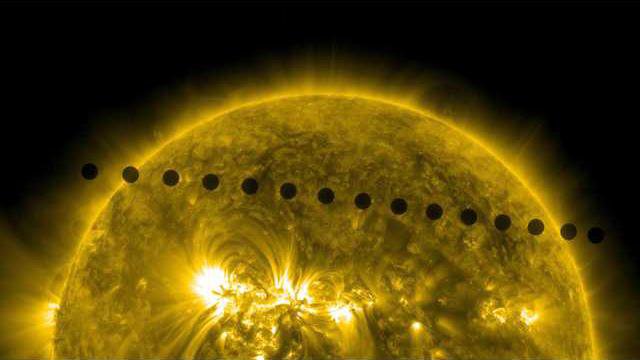THE SUN The planet Venus transit between Earth and the sun is not only rare, it is beautiful.
The transit only takes place twice in a lifetime, according to NASA officials. They reported that every 115 years the planets path crosses the space between the sun and Earth, with two transits occurring within eight years of each other.
A new study analyzing the most recent transit, which occurred in June 2012, was recently published in the journal Nature Communications. Researchers said the transit provided an opportunity to measure how the planets atmosphere absorbs different kinds of light.
A team from Italys University of Palermo used images of the transit captured in multiple wavelengths by NASA and the Japanese Aerospace Exploration Agency to complete the research.
During the transit, only the sides of the atmosphere could be seen, but they were particularly interesting areas, a statement from NASA reads. From the perspective of Venus, these were the areas where day turns into night and night turns into day on Earth, these transition areas can host interesting effects in the ionosphere. The data from the Venus transit showed that these two transition areas are virtually the same.
Researchers said they could detect that some high-energy wavelengths of light were absorbed in an upper layer atmosphere known as the thermosphere because it appeared opaque in high-energy wavelengths. Absorbed radiation created a layer of atmosphere called the ionosphere.
Because the energy in this light is captured by the ions, it is not re-emitted on the other side, the NASA statement reads. In certain wavelengths, Venus atmosphere is as solid as a wall, blocking light from traveling to our eyes. To our telescopes, the atmosphere is as dark as the planet itself so, Venus will appear to have a different size, depending on the wavelength of the telescopes pictures.
More details about the study can be found online. The next Venus transit is expected to take place in 2117.
The transit only takes place twice in a lifetime, according to NASA officials. They reported that every 115 years the planets path crosses the space between the sun and Earth, with two transits occurring within eight years of each other.
A new study analyzing the most recent transit, which occurred in June 2012, was recently published in the journal Nature Communications. Researchers said the transit provided an opportunity to measure how the planets atmosphere absorbs different kinds of light.
A team from Italys University of Palermo used images of the transit captured in multiple wavelengths by NASA and the Japanese Aerospace Exploration Agency to complete the research.
During the transit, only the sides of the atmosphere could be seen, but they were particularly interesting areas, a statement from NASA reads. From the perspective of Venus, these were the areas where day turns into night and night turns into day on Earth, these transition areas can host interesting effects in the ionosphere. The data from the Venus transit showed that these two transition areas are virtually the same.
Researchers said they could detect that some high-energy wavelengths of light were absorbed in an upper layer atmosphere known as the thermosphere because it appeared opaque in high-energy wavelengths. Absorbed radiation created a layer of atmosphere called the ionosphere.
Because the energy in this light is captured by the ions, it is not re-emitted on the other side, the NASA statement reads. In certain wavelengths, Venus atmosphere is as solid as a wall, blocking light from traveling to our eyes. To our telescopes, the atmosphere is as dark as the planet itself so, Venus will appear to have a different size, depending on the wavelength of the telescopes pictures.
More details about the study can be found online. The next Venus transit is expected to take place in 2117.








